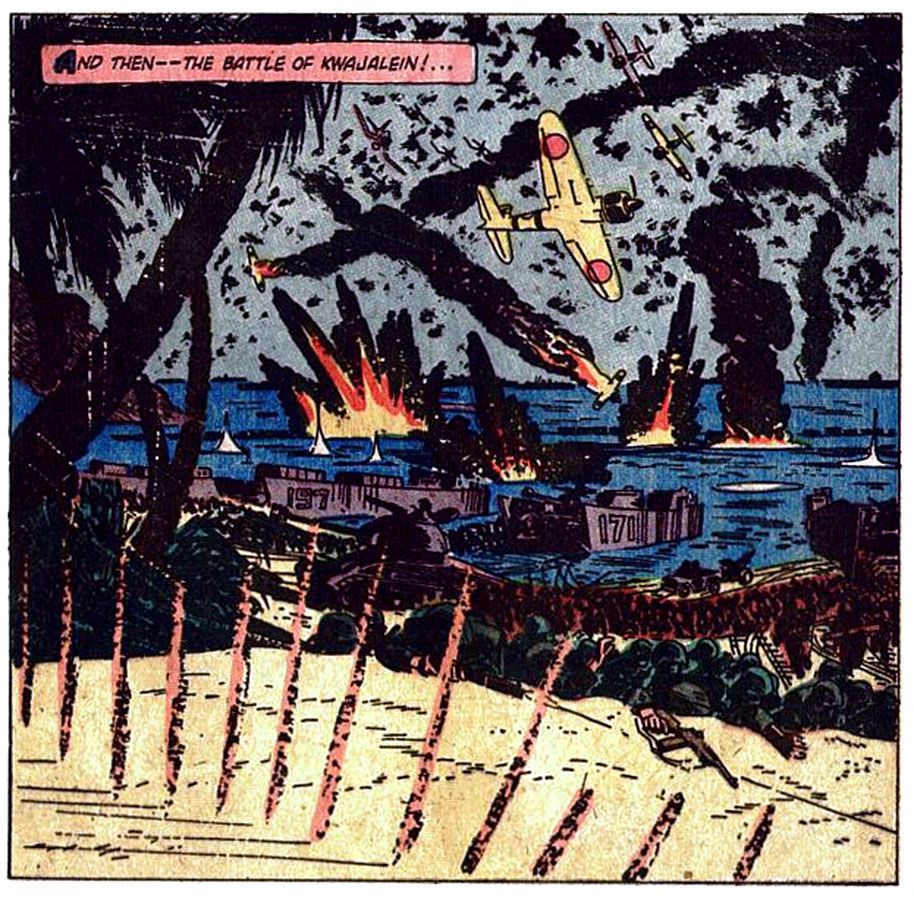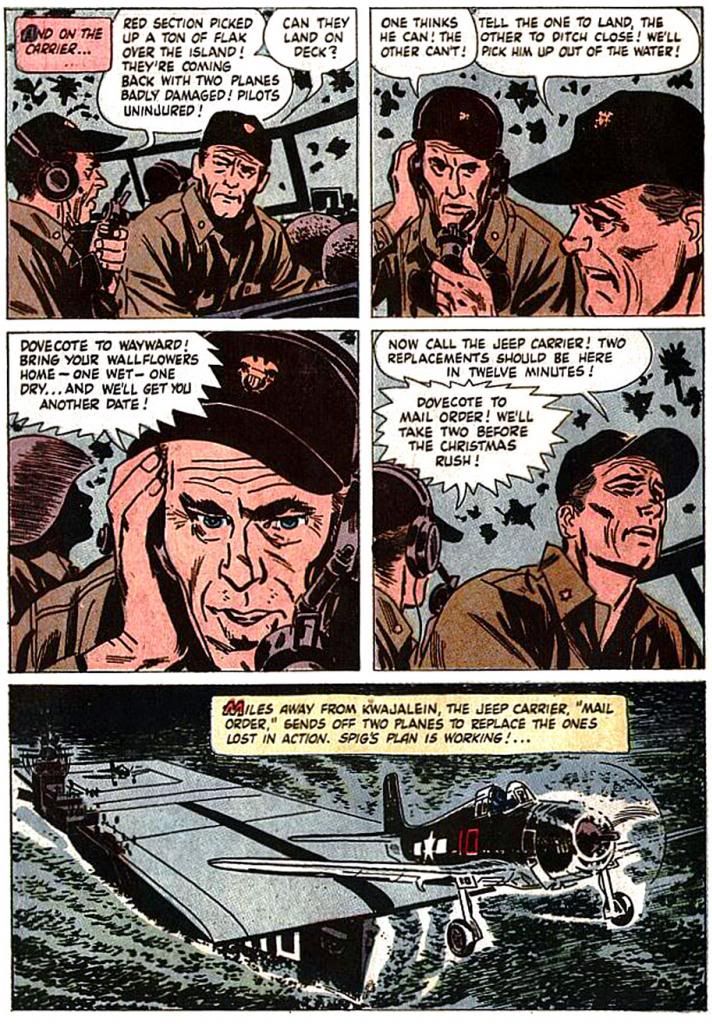Well, if you're doing a comic book version of a war movie about airplanes with John Wayne as the lead, you couldn't ask for a better artist than Alex Toth. Here he tackles the 1957 John Ford film The Wings of Eagles (Dell Four Color #790, April 1957). As far as I can remember, I haven't seen this movie, but after reading the comic, I'm thinking this is the kind of movie that doesn't innovate in an attempt to get at the inner desires and struggled of its subject, but just aims to please audiences with a rousing action story tribute to a guy who hobbled himself by accident but still went to war because he was so damned patriotic. A guy who just happened to have been good friends with the director himself.
Frank "Spig" Wead's life story kind of boggles the imagination and my first impression was, "No way." I mean, John Wayne as a hard-brawling guy named Spig?
But I did a little reading and I was wrong. While the photo I saw looks absolutely nothing like Wayne (a young David Strathairn comes immediately to mind), the real Wead actually was a pioneer of Naval aviation and carrier operations and part of a Navy flight team that won the Schneider Cup in 1923. Then he fell and broke his neck one night. Forced to retire from the Navy, Wead turned to expressing himself through writing and scripted films, mostly having to do with the military and flying. His film work netted him two Academy Award nominations. During WWII, Wead returned to service, helped develop the idea of the escort carrier (called "jeep" carriers in this comic), and even managed some sea duty aboard the carriers USS Yorktown and Essex.
Still, I can't help but think John Wayne was miscast in this film, or that Ford and company altered reality just a smidge to fit it to his oversized shoulders. While he certainly beat the drum as a patriot (despite not having actually put on a uniform in earnest), I simply can't imagine Wayne as a writer of any kind, military or not. Or hobbling around on crutches. If this Dell adaptation is accurate to the movie at all, it seems your typical mix of fact and Hollywood hokum... er... dramatic license, with events simplified and telescoped, secondary characters invented or composited. There's a thinly-disguised Ford stand-in played by Ward Bond. They call him John Dodge (clever, boys, clever!). There's a guy apparently based on Billy Mitchell who constantly fights with Wead (Toth depicts Wayne in the aftermath of these moments with cute little bandages on his face), which probably owes more to Flagg and Quirt from What Price Glory? than either Wead's or Mitchell's lives. There's a guy named Jughead, for chrissake! Even the film's title is a bit of a groaner.
But, as I said, I haven't seen it and there's always the Ford factor. Discount even a minor Ford film at your peril, and this one came in the wake of his superlative Western The Searchers. Whatever the quality of the movie it's based on, the book itself is aces, a little slice of perfection. Toth himself appears to have been thoroughly engaged by the material and just knocks himself out. He gets to draw airplanes from multiple eras and even a big time Hollywood movie premiere with 1930s-style cars. It's in the acting-- as well as the action-- that Toth really shines in this outing.
Here he pulls out the stops with unique facial expressions, really bringing the characters to life. His Wead/Wayne may not look a whole lot like the Duke-- other than matching him for imposing size compared to everyone else on the page-- but Toth nails the man's broad acting style. Even in scenes where the action is largely internal-- Wead struggles with writing inspiration and later, with the problem of prolonging carrier operations during invasions despite attrition in aircraft and men, Toth adds interest by choosing the right angle, the right facial expression. He once remarked something to the effect that some talky scenes will be by their very nature pedestrian, but he avoids that trap here. Or maybe it's just that the comedic drunken brawling and daredevil flying stuff more than make up for the internalized moments.
Despite the usual crap printing of the day, it's obvious even the coloring job is well thought-out. It uses a muted color scheme largely in various tints of blue, probably because so much of it takes place either in the air or on the sea. The colors don't exactly pop, but they're not garish nor do they battle Toth's line work. Check out this moody twilight scene:
Now we've all seen 1950s-era war flicks. They almost always save a bit of money by using stock footage. Authentic, but it's usually so glaringly obvious it throws me right out of the story. It also makes me wish I was simply watching a documentary so I can properly consider the millions of real people who died in pain and terror without the unfortunate context of their sacrifice serving to make John Wayne look like a great guy up on the silver screen. War comics of this era by their very nature-- generally aimed at kids-- tend to turn it all into a grand spectacle, with manly dogfaces stoically facing death or wisecracking their way through battles depending on the story's whims, largely sanitized to suit the Comics Code. Eagles is at least based on actual events, and Toth is untrammeled by budget considerations, so when he depicts life aboard a flattop doing its deadly business out there in the Pacific, we can imagine it's the real thing and not some rear-projected footage on a soundstage in Los Angeles.
His major battle scene in the book is a single over-sized panel that's practically a whole school on controlling eye movement and presenting depth in itself. In the foreground, there are machine gun strikes, then a middle-ground plane made up of palm trees and the invasion force itself, with troops and a tank largely suggested through silhouetting, a bright flash of a Zero overhead drawing our gaze upward into the background, a sky Toth speckles with angry ink blotches representing flak. It's appropriately hectic and violent, certainly doesn't look like fun for Gunner and Sarge. Toth compresses a whole day's worth of death and destruction into this single image.
This is contrasted on the next page by some talking heads which bring us back into the story proper and provide tension. Then, another incredible panel of a Wildcat taking off, reminding us of the scope of the day's events and showing us Spig's grand idea coming to fruition.
I can't imagine Ford-- unlike Wayne, Ford knew war first-hand, having been wounded at Midway and present on Omaha Beach itself during the D-Day invasion-- reading this and feeling his cinematic vision slighted. This is some sterling Toth, and really deserves another look. Fortunately, you can find the whole thing online at a couple of different blogs to enjoy for yourself.




No comments:
Post a Comment